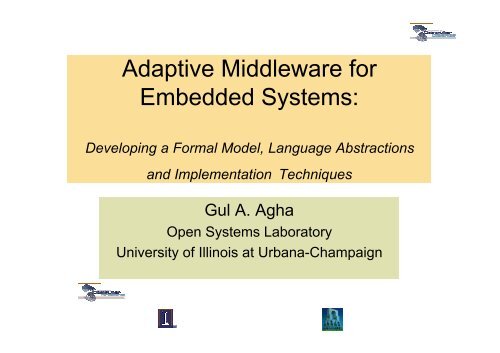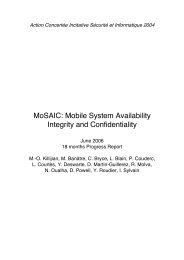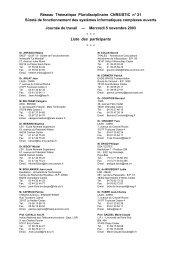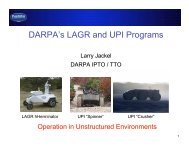Adaptive Middleware for Embedded Systems:
Adaptive Middleware for Embedded Systems:
Adaptive Middleware for Embedded Systems:
You also want an ePaper? Increase the reach of your titles
YUMPU automatically turns print PDFs into web optimized ePapers that Google loves.
<strong>Adaptive</strong> <strong>Middleware</strong> <strong>for</strong><br />
<strong>Embedded</strong> <strong>Systems</strong>:<br />
Developing a Formal Model, Language Abstractions<br />
and Implementation Techniques<br />
Gul A. Agha<br />
Open <strong>Systems</strong> Laboratory<br />
University of Illinois at Urbana-Champaign
Acknowledgements<br />
Joint work with<br />
• Carolyn Talcott, SRI<br />
• Nalini Venkatasubramanian, UC Irvine<br />
• Dan Sturman and Mark Astley, IBM Research<br />
• Svend Frolund, HP Labs<br />
• Other Current and Former Members of OSL<br />
• Supported by DARPA Nest Program, ONR and<br />
National Science Foundation<br />
Jan 7, 2003 UIUC OSL <strong>Middleware</strong> 2
Open Distributed <strong>Systems</strong><br />
(ODS)<br />
Electronic<br />
Commerce<br />
Video<br />
Servers<br />
Entertainment<br />
Web<br />
Servers<br />
Distance Learning<br />
Tele-medicine<br />
Graphics<br />
Processing<br />
Requirements - Availability, Reliability, Quality-of-Service, Security, Adaptability<br />
Jan 7, 2003 UIUC OSL <strong>Middleware</strong> 3
Outline of Talk<br />
• Context and motivation<br />
• Formal Methods <strong>for</strong> Distributed <strong>Middleware</strong><br />
– Actor theories and the TLAM<br />
– Examples<br />
• Network <strong>Embedded</strong> <strong>Systems</strong><br />
– Modeling Issues<br />
– Example NEST <strong>Middleware</strong> Architecture<br />
• Research Directions<br />
Jan 7, 2003 UIUC OSL <strong>Middleware</strong> 4
From a System Designer or<br />
Programmer Point of View<br />
• Would like to design and program at the<br />
level of interaction between applications<br />
• Want to specify and program different<br />
concerns separately<br />
–basic functionality<br />
–security<br />
–dependability / availability<br />
–real-time requirements<br />
Jan 7, 2003 UIUC OSL <strong>Middleware</strong> 5
Problems<br />
• OS provides only low level communication and<br />
resource management<br />
• Different languages have different<br />
representations and interaction mechanisms<br />
• Coordination of distributed components is<br />
complex<br />
• Assuring non-interference -- concurrently<br />
executing `independent’ services may share<br />
– resources -- bandwidth, cycles, memory<br />
– in<strong>for</strong>mation -- database, sensors/actuators<br />
Jan 7, 2003 UIUC OSL <strong>Middleware</strong> 6
Distributed <strong>Systems</strong> <strong>Middleware</strong><br />
• Enables communication across multiple<br />
– computers<br />
– programming languages<br />
– data representations<br />
• Can support QoS requirements<br />
• Provide services <strong>for</strong> higher-level programming<br />
abstractions, e.g.<br />
– group communication<br />
– transactions<br />
– data aggregation<br />
Jan 7, 2003 UIUC OSL <strong>Middleware</strong> 7
Basic <strong>Middleware</strong> Services<br />
<strong>Middleware</strong> services may be built out of basic services:<br />
• Communication:<br />
– location transparency<br />
– marshalling/unmarshalling arguments<br />
• Naming / directory<br />
– locating objects / services<br />
• Life cycle<br />
– create, activate, stop, delete<br />
– copy (across machine)<br />
– persistence (save, restore)<br />
• Scheduling<br />
Jan 7, 2003 UIUC OSL <strong>Middleware</strong> 8
<strong>Middleware</strong> needs<br />
<strong>for</strong>mal methods support<br />
• Agreed upon standards <strong>for</strong> services and<br />
their interfaces (APIs)<br />
• Notion of con<strong>for</strong>mance to standards<br />
• Analysis of standards and service<br />
specifications<br />
–what assumptions do they make <strong>for</strong> correct<br />
operation?<br />
–what are the potential (positive or negative)<br />
interactions?<br />
Jan 7, 2003 UIUC OSL <strong>Middleware</strong> 9
Two Level Actor Machine<br />
(TLAM)<br />
• A semantic framework <strong>for</strong> specifying and<br />
reasoning about middleware services.<br />
• Based on the actor computation model <strong>for</strong><br />
Open Distributed <strong>Systems</strong>:<br />
– base-level actors model application<br />
functionality.<br />
– meta-level actors model middleware services.<br />
• Use of core services to isolate interactions.<br />
• Specification viewpoints<br />
Jan 7, 2003 UIUC OSL <strong>Middleware</strong> 10
The Actor Model<br />
A Model of Distributed Object<br />
Computation<br />
Interface<br />
Thread<br />
State<br />
Thread<br />
State<br />
Interface<br />
Messages<br />
Procedure<br />
Procedure<br />
Interface<br />
Thread<br />
State<br />
Procedure<br />
Jan 7, 2003 UIUC OSL <strong>Middleware</strong> 11
Core Services<br />
Meta (System) Level<br />
Replication<br />
DGC<br />
Access<br />
Control<br />
Migration<br />
Checkpointing<br />
Remote<br />
Creation<br />
Distributed<br />
Snapshot<br />
Directory<br />
Services<br />
Base (Application) Level<br />
Base (Application) Level<br />
Core services allow us to isolate complex interactions<br />
-- useful <strong>for</strong> managing composition of services<br />
Jan 7, 2003 UIUC OSL <strong>Middleware</strong> 12
Specification Viewpoints<br />
System<br />
specification<br />
(S)<br />
Global System Functions<br />
Global System Functions<br />
Application<br />
Application<br />
End-End<br />
service<br />
specificati<br />
on<br />
(E)<br />
meta<br />
behavior<br />
...<br />
meta<br />
behavior<br />
Procedure<br />
State<br />
Behavior<br />
specification<br />
(B)<br />
Algorithmic<br />
specification<br />
(A)<br />
Node Base System<br />
Jan 7, 2003 UIUC OSL <strong>Middleware</strong> 13
Relating Specification<br />
Viewpoints<br />
• (S => E) system spec implies end-to-end service<br />
spec<br />
• (B => S if I and NI) behavior spec implies<br />
system spec if<br />
– (I) initial conditions satisfied<br />
– (NI) non-interference conditions satisfied<br />
• (A=>B) algorithm spec implies behavior spec<br />
• .....<br />
Jan 7, 2003 UIUC OSL <strong>Middleware</strong> 14
Actor Theories<br />
• Actor theories specify:<br />
– the set of individual actor states<br />
– the set of messages<br />
– reaction rules that determine how an actor in a given<br />
state may evolve<br />
• An actor system configuration is a `soup’ of<br />
actors and messages -- a global snapshot from<br />
some viewpoint<br />
• An actor system evolves by (concurrent)<br />
application of the reaction rules (fairly applied)<br />
Jan 7, 2003 UIUC OSL <strong>Middleware</strong> 15
Ticker Actor Specification<br />
For c,t actor ids, n a number<br />
• States: T(n)<br />
• Messages: tick, time@c, reply(n)<br />
• Reaction Rules:<br />
( t | T(n) ) t ← tick<br />
==><br />
( t | T(n+1) ) t ← tick<br />
( t | T(n) ) t ← time@c<br />
==><br />
( t | T(n) ) c ← reply(n)<br />
Jan 7, 2003 UIUC OSL <strong>Middleware</strong> 16
Ticker Actor Scenario<br />
...<br />
(c|..t..)<br />
(t|T(2))<br />
t←tick<br />
...<br />
dlv(t←tick) ... c ...<br />
(t|T(3))<br />
t←tick<br />
...<br />
t←time@c dlv(t←time@c)<br />
(c|..t..)<br />
(t|T(3))<br />
t←tick<br />
c←reply(3)<br />
...<br />
(c|..t..)<br />
Jan 7, 2003 UIUC OSL <strong>Middleware</strong> 17
The Two Level Actor Model<br />
(TLAM)<br />
• Stratify actors into<br />
– Base-level actors (application)<br />
– Meta-level actors (system level / middleware)<br />
• Base-level actors and messages are augmented with annotations<br />
(meta-data)<br />
• Actors and undelivered messages are distributed over a network of<br />
nodes and links<br />
• Meta-level actors<br />
– can examine/modify runtime state and annotations of colocated baselevel<br />
objects<br />
– react to local base-level events of interest<br />
– cooperate with possibly remote meta actors to provide system wide<br />
services.<br />
Jan 7, 2003 UIUC OSL <strong>Middleware</strong> 18
Two Level Actor Theory<br />
• An actor theory extend by<br />
– annotations <strong>for</strong> base actor states and messages<br />
– a set of meta actor states<br />
– a set of meta-level messages<br />
– reaction rules <strong>for</strong> meta-actor<br />
• parameterized by local base-level configuration<br />
– event handling rules that determine how a meta-actor<br />
reacts to base level events (changes due to base-level<br />
reactions or to meta-level modifications)<br />
Jan 7, 2003 UIUC OSL <strong>Middleware</strong> 19
Ticker Monitor Specification<br />
• States: M(t,mc,m)<br />
• Messages: log(t,n,m,c), reset, reset-ack<br />
– t,mc,c are actor ids, n,m are numbers<br />
• Reaction Rules:<br />
(tm | M(t,mc,m))<br />
={dlv((t|T(n))t←time@c)/ }=><br />
(tm | M(t,mc,m+1)) mc ← log(t,n,m+1,c)<br />
(tm | M(t,mc,m)) tm ← reset<br />
={ /t:=T(0)}=><br />
(tm | M(t,mc,0)) mc ← reset-ack<br />
Jan 7, 2003 UIUC OSL <strong>Middleware</strong> 20
Monitored Ticker Scenario<br />
(tm|M(t,mc,0))<br />
(t|T(2))<br />
... t←tick<br />
...<br />
(c|..t..)<br />
dlv(t←tick) ... c ...<br />
(tm|M(t,mc,0))<br />
(t|T(3))<br />
... t←tick<br />
t←time@c<br />
(c|..t..)<br />
dlv(t←time@c)<br />
mc←log(t,3,1,c)<br />
(tm|M(t,mc,1))<br />
(t|T(3))<br />
t←tick<br />
c←reply(3)<br />
...<br />
(c|..t..)<br />
Jan 7, 2003 UIUC OSL <strong>Middleware</strong> 21
Log Service Example<br />
A logging service<br />
• Logs messages delivered to a given set of<br />
base actors, and<br />
• When requested reports the messages<br />
logged since the previous request.<br />
Jan 7, 2003 UIUC OSL <strong>Middleware</strong> 22
Logging Non-interference<br />
Requirement<br />
• A system S satisfies the logging noninterference<br />
requirement if:<br />
– non-logging meta actors do not set Log<br />
attributes<br />
– the only messages sent to logging meta<br />
actors by non-logging meta actors are log<br />
request messages addressed to the log server<br />
Jan 7, 2003 UIUC OSL <strong>Middleware</strong> 23
Logging Theorems<br />
• Theorem 1 (Base-meta noninterference)<br />
–If system S has Logging Behavior, then Log<br />
meta-actors of S preserve base-level<br />
behavior.<br />
• Theorem 2 (Behavior implies service)<br />
–If system S has Logging Behavior and<br />
satisfies the logging initial conditions and noninterference<br />
requirements, then S provides<br />
logging service.<br />
Jan 7, 2003 UIUC OSL <strong>Middleware</strong> 24
Other Case Studies<br />
using TLAM<br />
• QoS based Multimedia (MM) Server<br />
–Serves requests <strong>for</strong> presentation of MM<br />
object with specified QoS (latency, jitter,<br />
frame-rate ...)<br />
–End-end spec:<br />
• every request is either served with the required<br />
QoS, or<br />
• explicitly denied if QoS requirements can not be<br />
met<br />
Jan 7, 2003 UIUC OSL <strong>Middleware</strong> 25
Network <strong>Embedded</strong> <strong>Systems</strong><br />
• From web of computers to web of<br />
everything!<br />
• Paradigm shift from distributed to network<br />
embedded systems<br />
– Large-Scale<br />
– Real-time sensors and actuators<br />
– Integration of Discrete and Continuous<br />
processes<br />
Jan 7, 2003 UIUC OSL <strong>Middleware</strong> 26
Modeling Issues <strong>for</strong> NEST<br />
• Large scale network embedded<br />
systems exhibit behaviors that need<br />
stochastic analysis.<br />
– Unpredictable node failures, random<br />
communication delay, emerging properties<br />
in work load.<br />
– Incomplete knowledge and uncertainty<br />
lead to probabilistic approximation.<br />
Jan 7, 2003 UIUC OSL <strong>Middleware</strong> 27
Develop a Probabilistic Variant of Real-time<br />
Concurrency Semantics<br />
• Probabilities on<br />
transitions.<br />
• Summations over<br />
execution paths<br />
<strong>for</strong> statistical metrics.<br />
• Quantify approximation<br />
and timeliness.<br />
Jan 7, 2003 UIUC OSL <strong>Middleware</strong> 28
Distributed Model of Time<br />
• Global synchronous wall clock<br />
– Synchronization is too tight<br />
– Too detailed an execution model<br />
• Asynchronous, distributed time<br />
– Vector clocks are too expensive<br />
– Application behavior is complicated<br />
Need a more expressive model of<br />
time:<br />
• Notion of distance and distribution.<br />
• Space-Time cone of causal<br />
influence.<br />
Not<br />
Causally<br />
related<br />
y<br />
t<br />
R<br />
Light Cones<br />
Future<br />
causality<br />
S<br />
Q<br />
P<br />
x<br />
Past<br />
causally<br />
connected<br />
Jan 7, 2003 UIUC OSL <strong>Middleware</strong> 29
Distributed Time and Probability<br />
• Events separated in space<br />
are separated in time:<br />
– Scheduling delays<br />
– Latency and communication<br />
delays<br />
• Such delays are<br />
probabilistic in nature<br />
• Probabilistic cone<br />
Not<br />
Causally<br />
related<br />
y<br />
t<br />
R<br />
S’<br />
Future<br />
causality<br />
Q<br />
S<br />
x<br />
x<br />
Past<br />
causally<br />
connected<br />
Q’<br />
P<br />
Jan 7, 2003 UIUC OSL <strong>Middleware</strong> 30
Probabilities in Actor Semantics<br />
Non-determinism in message order replaced by<br />
probability distribution<br />
Total asynchrony replaced by probabilistic delay<br />
Actors<br />
0.2<br />
0.8<br />
Message delay density function<br />
p(t)<br />
Jan 7, 2003 UIUC OSL <strong>Middleware</strong> 31
Probabilistic Rewrite Theory<br />
• Rewrite theories are abstract (economic<br />
specifications).<br />
• Rewrite theories can be efficiently<br />
implemented (in Maude).<br />
• Probabilistic rewrite theory can be used to<br />
<strong>for</strong>mally reason about large-scale network<br />
embedded systems.<br />
• Time skews subsumed by probabilities.<br />
Jan 7, 2003 UIUC OSL <strong>Middleware</strong> 32
Probabilistic Rewrite Theory<br />
R = (Σ,E,L,R,ρ)<br />
• Σ is a signature (sorts and operation<br />
declarations)<br />
• E is a set of equations<br />
• L is set of labels (of rewrite rules)<br />
• R is set of rewrite rules<br />
• ρ is a rate function: ρ maps a rule of the <strong>for</strong>m<br />
l : t → t’ if C i i to a positive real r<br />
Jan 7, 2003 UIUC OSL <strong>Middleware</strong> 33
Probabilistic Rewrite Theory (contd.)<br />
For each label l ε L and its associated rule, there are probabilistic rewrite rules:<br />
l : t → t’ if 1 C [rate r 1 1 (X)]<br />
……<br />
l : t → t’ if n C [rate r n n (X)]<br />
where C i<br />
is a conjunction of equation and membership predicates.<br />
Let T Σ/E<br />
be the ground terms in the initial algebra of a probabilistic rewrite<br />
theory. Then<br />
where<br />
ρ : R → T Σ/E<br />
(X) PosReal<br />
- X is the set of all free variables in t , t’ 1 , …, t’ n<br />
- PosReal is the sort of positive real numbers<br />
Jan 7, 2003 UIUC OSL <strong>Middleware</strong> 34
Example<br />
Modeling node failures<br />
[crl] mote ⇒ fail if cond(x,y) [metadata “p(z)”]<br />
[crl] mote ⇒ doAction [metadata “1-p(z)”]<br />
failures<br />
Modeling randomized algorithms<br />
[crl] State ⇒ S(A) if cond (x) [metadata “p(y)”]<br />
[crl] State ⇒ S(B) if cond (z) [metadata “0.2”]<br />
Delays<br />
Modeling communication delays<br />
[rl] m ⇒<br />
[metadata “p(x)”]<br />
Jan 7, 2003 UIUC OSL <strong>Middleware</strong> 35
Building Network <strong>Embedded</strong><br />
<strong>Systems</strong><br />
• An exact solution is not always necessary<br />
– Particularly in sensor network applications<br />
• An exact solution is not always of our best interest.<br />
– Late messages are often useless.<br />
– They may be even adverse.<br />
• Get a rough estimate first, then refine the answer.<br />
• The quality of approximation increases with time.<br />
Jan 7, 2003 UIUC OSL <strong>Middleware</strong> 36
Global Function Evaluation<br />
Evaluate a function which is dependent both on the<br />
state of a node in the network and time.<br />
Issues<br />
• Scalability<br />
e.g., 10 5 nodes ⇒ (at least) ~10 5 messages ⇒ congestion<br />
• Timeliness in response and other real-time constraints<br />
– unpredictable propagation delays<br />
• Reliability/dependability<br />
– unreliable communication channels<br />
Approach<br />
• Use Approximation!<br />
Jan 7, 2003 UIUC OSL <strong>Middleware</strong> 37
Observations on Approximate GFE<br />
• Unless an exact answer is required, reliable<br />
communication protocols too expensive.<br />
• Early estimates alleviate some real-time concerns.<br />
• Scalability issues:<br />
– Prolong data aggregation phase to alleviate<br />
congestion.<br />
– Zoom in on interesting portions of the network.<br />
• Results can be analyzed using a probabilistic model.<br />
Jan 7, 2003 UIUC OSL <strong>Middleware</strong> 38
Approximate GFE<br />
• F(<br />
S,<br />
t)<br />
– function of interest<br />
S = global state t = time<br />
• A( x,<br />
t)<br />
– quality of approximation<br />
x<br />
= network conditions, # of nodes, etc.<br />
• Some approximation techniques are<br />
independent of F.<br />
Jan 7, 2003 UIUC OSL <strong>Middleware</strong> 39
Example GFE:<br />
Locating a Mobile Target<br />
• Discover and extrapolate the path of an<br />
evader moving (linearly) through a sensor<br />
grid.<br />
• F(S,t): Ax + By = 0 with global state S and<br />
time t.<br />
• The quality of approximation depends on<br />
– The number of sensor readings<br />
– The accuracy/consistency of sensor<br />
readings<br />
Jan 7, 2003 UIUC OSL <strong>Middleware</strong> 40
Prototype GFE Node Architecture<br />
Application<br />
<strong>Middleware</strong> layer<br />
Data<br />
Aggregation<br />
Spanning Tree<br />
Maintenance<br />
Messaging<br />
Layer<br />
Jan 7, 2003 UIUC OSL <strong>Middleware</strong> 41
Application module<br />
• Implements application<br />
dependent functionality:<br />
– Sensor reading<br />
– Data processing<br />
• Customizes data<br />
aggregation functionality<br />
Data<br />
Aggregation<br />
Application<br />
Messaging<br />
Layer<br />
Spanning Tree<br />
Maintenance<br />
Jan 7, 2003 UIUC OSL <strong>Middleware</strong> 42
Aggregation Module<br />
• Provides services <strong>for</strong>:<br />
– Storing a message<br />
– Application-assisted message<br />
aggregation<br />
– Rate-controlled message<br />
transmission<br />
• Alleviates congestion<br />
• Enables reduced power<br />
consumption<br />
• En<strong>for</strong>ces stabilization policies:<br />
– Control the age of messages<br />
accepted<br />
– Control local congestion<br />
Data<br />
Aggregation<br />
Application<br />
Messaging<br />
Layer<br />
Spanning Tree<br />
Maintenance<br />
Jan 7, 2003 UIUC OSL <strong>Middleware</strong> 43
Spanning Tree Module<br />
• Periodically broadcasts<br />
heartbeats:<br />
– construct spanning tree<br />
– prune dead nodes<br />
– control topology<br />
• Reduces interference<br />
with application<br />
messages<br />
– common messaging<br />
layer allows sending tree<br />
messages during idle<br />
intervals<br />
Data<br />
Aggregation<br />
Application<br />
Messaging<br />
Layer<br />
Spanning Tree<br />
Maintenance<br />
Jan 7, 2003 UIUC OSL <strong>Middleware</strong> 44
Approximating Movement<br />
1. Monitoring motes know their<br />
location<br />
• Currently hard-coded<br />
• Will be computed dynamically<br />
2. Time synchronization available<br />
• Currently primitive, coarse grain<br />
time synchronization.<br />
• Will use an accurate time<br />
synchronization which helps<br />
synchronize intervals of low<br />
power operation.<br />
Jan 7, 2003 UIUC OSL <strong>Middleware</strong> 45
Measure of Approximation<br />
• Use slope of the line as the measure of<br />
correctness of approximation<br />
– Scalability through piece-wise linear construction<br />
of line (introduce memory loss)<br />
• Approximation defined as difference between<br />
measured slope and real slope<br />
– Expressed as a percentage<br />
• Take real slope to be the last estimate of the<br />
slope<br />
– Best solution given all available data<br />
Jan 7, 2003 UIUC OSL <strong>Middleware</strong> 46
Approximation Error vs. Time<br />
Approximation Error<br />
100%<br />
90%<br />
80%<br />
70%<br />
60%<br />
50%<br />
40%<br />
30%<br />
20%<br />
10%<br />
0%<br />
30 50 70 90 110 130<br />
Time<br />
Jan 7, 2003 UIUC OSL <strong>Middleware</strong> 47
Summary<br />
• <strong>Middleware</strong> is ripe <strong>for</strong> <strong>for</strong>mal<br />
specification and analysis.<br />
• TLAM is a semantic framework <strong>for</strong><br />
specifying and reasoning about<br />
middleware services<br />
• Probabilistic models are required <strong>for</strong><br />
network embedded systems<br />
–Statistical approximations<br />
Jan 7, 2003 UIUC OSL <strong>Middleware</strong> 48
Future Directions<br />
• Formal Models <strong>for</strong> <strong>Middleware</strong> extending<br />
Two-Level Actor Semantics:<br />
– Probabilistic<br />
– Distributed Time<br />
– Hybrid<br />
• Provide <strong>for</strong>mal definition <strong>for</strong> middleware<br />
• Study network embedded systems<br />
example applications<br />
Jan 7, 2003 UIUC OSL <strong>Middleware</strong> 49









